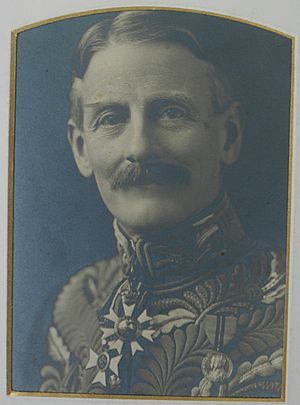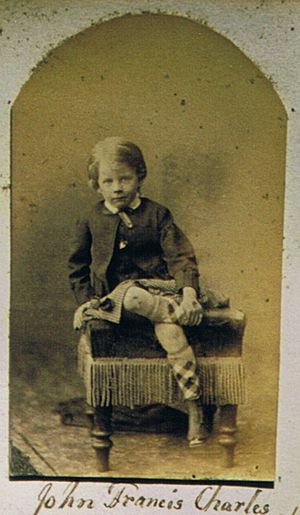John Francis Charles, 7th Count de Salis-Soglio facts for kids
Sir John Francis Charles de Salis (born July 19, 1864 – died January 14, 1939) was an important British diplomat and landowner. He was also known as the 7th Count de Salis. He came from an Anglo-Irish family and spent his life working for his country in different parts of the world.
Contents
Meet Sir John de Salis
Sir John Francis Charles de Salis was born on July 19, 1864. He passed away on January 14, 1939. He was a British diplomat and also owned a lot of land. He held the title of 7th Count de Salis.
His Family and Early Life
John was the older son of Count John Francis William de Salis. His father was also a diplomat and studied old coins. His mother was Amelia Frances Harriet. She was the eldest daughter of Christopher Tower, a well-known person from Buckinghamshire and Essex.
A Career in Diplomacy
John de Salis went to Eton College from 1877 to 1882. After finishing school, he joined the diplomatic service on November 20, 1886. A diplomat represents their country in other nations. He passed his exams in January 1887.
- On June 12, 1888, he started working in Brussels.
- He was promoted to Third Secretary in January 1889.
- From April 1892, he worked in Madrid.
- He became Second Secretary in August 1893.
- In August 1894, he moved to Cairo, Egypt. He worked under Lord Cromer there. He even learned Arabic, which helped him in his job.
- Later, he worked in Berlin in 1897 and Brussels again in 1899.
- From 1901, he was in Athens, Greece. He helped deal with issues in the region.
- He became First Secretary on April 1, 1904.
- Between 1901 and 1906, he worked at the Foreign Office in London.
- He helped negotiate a new trade agreement with Romania in 1905.
- From 1906 to 1911, he was a senior diplomat in Berlin.
- He also represented Britain at a meeting about copyright in Berlin in 1908.
- From 1911 to 1916, he was the main British representative in Montenegro.
- Later, from 1916 to 1923, he served as a special envoy to the Holy See (the Vatican). He worked with two Popes, Pope Benedict XV and Pope Pius XI.
- In 1931, he was part of a special group that looked into issues in Malta.
The Montenegro Report
In 1919, the British government asked John de Salis to investigate what was happening in Montenegro. This country had been occupied by Serbia. He wrote a report about his findings. However, this report was kept secret by the government.
Many people wondered why the report was not made public. Some believed it showed serious problems with Serbian rule in Montenegro. They thought publishing it would cause international issues.
- Ronald McNeill, a member of Parliament, often asked about the report.
- Lord Sydenham also spoke about it in the House of Lords. He mentioned that the report contained names of people who gave secret information. Releasing their names could put them in danger.
A newspaper article in The New York Times in 1922 described Count de Salis as "perhaps the greatest English authority on the Balkans." This shows how respected his knowledge was.
The New York Times also reported in April 1920 about an alleged event. It said that Serbs had arrested de Salis. The Montenegran Foreign Minister claimed this to King Nicholas of Montenegro. The minister said that the British government had hidden de Salis's report. This report supposedly said that the Serbian army "terrorized the population" in Montenegro. The minister also claimed that Europe and even President Wilson were ignoring the situation.
Only one of the four obituaries for Sir John de Salis in The Times newspaper mentioned his report on Montenegro. This shows how sensitive the topic remained.
His Marriage
In 1890, John de Salis married Hélène Marie de Riquet. She was the Comtesse de Caraman-Chimay. She was born on August 18, 1864, and passed away on May 31, 1902. Her father was Prince de Caraman-Chimay.



